Home
> Scales
> Major
Blues
Scales
This lesson will show you how to integrate other scale options that will add more color to your solos and give you more creative room to express yourself.
By familiarizing yourself with the scale options we're about to look at, you'll give intuition a greater role in crafting your phrasing. Your expression will no longer be limited to a single, fixed position, six-note scale.
So, the focus of this lesson is on changing scales through a typical major key blues progression (I, IV, V). Watch the video for an overview and then use the material below to fully internalize it. Take your time...
The key is always determined by the root of the I chord. The IV and V chord roots can be visualized in relation to that using the following diagrams...
Tonic on the E string Tonic on the A string

Test yourself! If the key was C, at which frets would these root positions be on both strings? What if the key was G, or E? These are the most common blues keys (A and E should be your priority). For example, here's how things would look if the tonic/key was A.

Once you're confident with locating these root positions in different keys, we can move on to learning our scale patterns.
Each chord in a major key blues progression will typically be made up of these core intervals. That means by targeting these tones in our scale phrases, we'll keep our solos connected to the backing music.
For example, taking the intervals of Mixolydian - 1 2 3 4 5 6 b7 - we can see all the chord tones exist within this pattern.
However, with scales like minor blues - 1 b3 4 b5 5 b7 - we may need to add in the major 3rd occasionally to give it more color. More on this in a moment.
Again, it's easiest to visualize scale patterns in two initial root positions - E string and A string. For example, the root note A can be found at the 5th fret on the E string and 12th fret on the A string, allowing us to build (and later connect) two patterns for each scale.
Always look for that E/A string root reference - this tells you where the appropriate scale patterns should sit.
Jam: As you learn them, try practicing these scales by using the tracks below. Each track is just one chord all the way through, so you don't have to think about changing positions at this stage. Just practice different scales on the same root...
 A track
A track
 D track
D track
 E track
E track
Remember to add in that major 3rd chord tone occasionally. Wherever the b3 exists, the 3 is just to the right of it!
E string root pattern

^ There's your E string root reference!
A string root pattern

^ There's your A string root reference!
E string root pattern
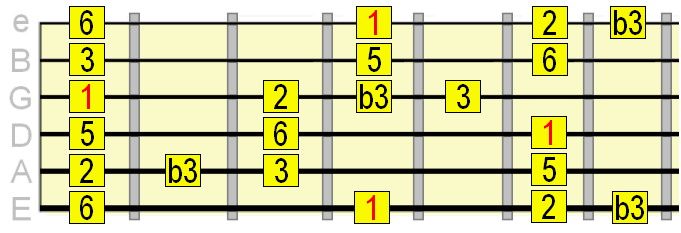
A string root pattern
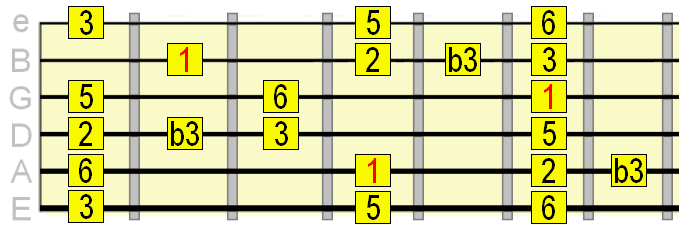
E string root pattern

A string root pattern
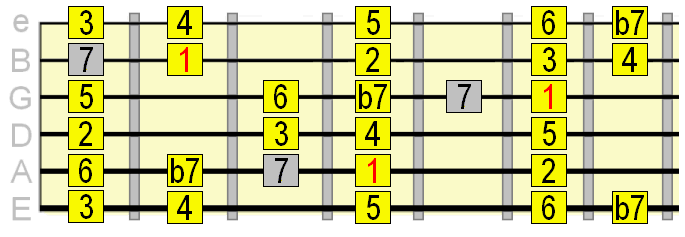
E string root pattern

A string root pattern
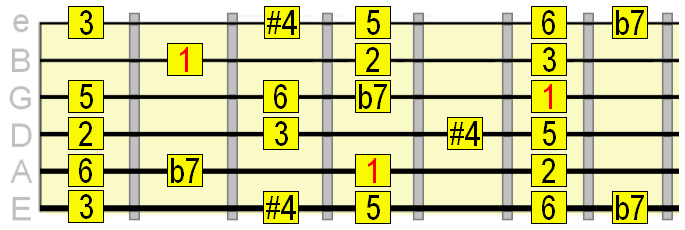
E string root pattern
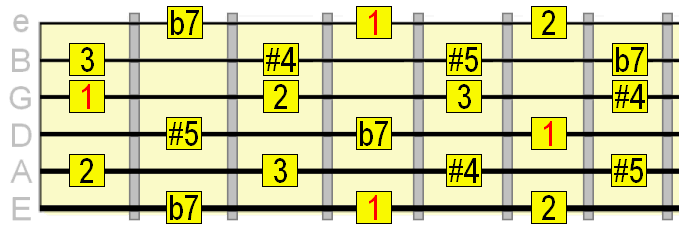
A string root pattern
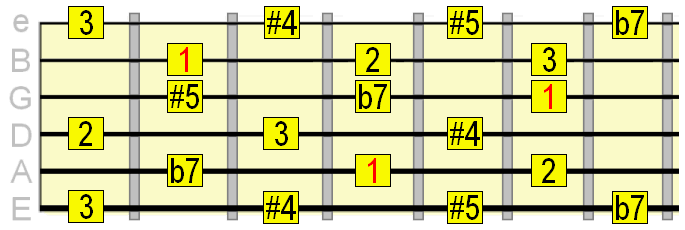
For example, let's say we chose the minor blues scale. Here's how we would move through an A major key progression (I've included the colored root position markers from earlier)...
Over A7

Note: above I've linked together the E and A string root patterns, but at first just keep it simple and choose a small segment of one pattern (E string pattern is usually the default) that you can then move to the other chord roots.
Over D7

Over E7

Moving between scales mid-phrase will come naturally as you get to know the individual scales more intimately, but here are a couple of examples of composite/hybrid scales. Listen to how the color changes as you move up or down the scale...
From top to bottom... minor blues > Mixolydian / bebop dominant > minor blues
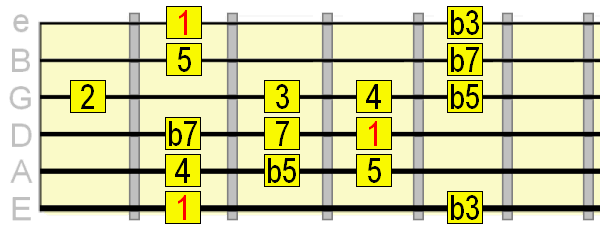
From top to bottom... mixolydian > minor blues > lydian dominant
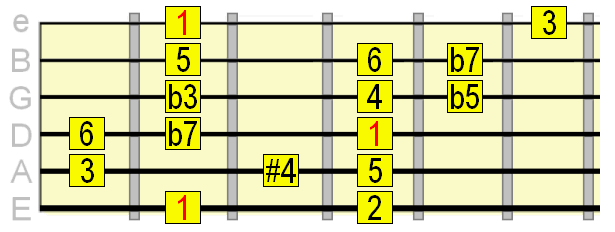
While this lesson has obviously been blues focused, the skill of being able to improvise scale changes is style independent. Blues is a great form to develop these fundamental skills, whether you listen to it or not! Thanks for your time.
Share your thoughts...
Have any questions, thoughts or ideas about this lesson? Let us know using the comments form below.
Major Blues Scale Changes - The Ultimate Roadmap
In my preliminary lesson on soloing over blues progressions, we looked at simple ways to give good ol' minor pentatonic more mileage in your blues guitar solos.This lesson will show you how to integrate other scale options that will add more color to your solos and give you more creative room to express yourself.
By familiarizing yourself with the scale options we're about to look at, you'll give intuition a greater role in crafting your phrasing. Your expression will no longer be limited to a single, fixed position, six-note scale.
So, the focus of this lesson is on changing scales through a typical major key blues progression (I, IV, V). Watch the video for an overview and then use the material below to fully internalize it. Take your time...
Creating the Roadmap - Root Positions
First, we need to learn the root positions for each chord (I, IV, V). By doing this, you'll be able to position your scale patterns at the appropriate fret, no matter what key you're playing in. To do this you need to have at least learned the notes on the E and A strings.The key is always determined by the root of the I chord. The IV and V chord roots can be visualized in relation to that using the following diagrams...
Tonic on the E string Tonic on the A string

Test yourself! If the key was C, at which frets would these root positions be on both strings? What if the key was G, or E? These are the most common blues keys (A and E should be your priority). For example, here's how things would look if the tonic/key was A.

Once you're confident with locating these root positions in different keys, we can move on to learning our scale patterns.
A Note About Chord Tones
As you go through the scale patterns below, keep an eye out for any of the following intervals - 1 3 5 b7. These are our dominant 7th chord tones.Each chord in a major key blues progression will typically be made up of these core intervals. That means by targeting these tones in our scale phrases, we'll keep our solos connected to the backing music.
For example, taking the intervals of Mixolydian - 1 2 3 4 5 6 b7 - we can see all the chord tones exist within this pattern.
However, with scales like minor blues - 1 b3 4 b5 5 b7 - we may need to add in the major 3rd occasionally to give it more color. More on this in a moment.
Major Blues Scale Options - Beyond Pentatonic
As we learned in the video, there are numerous ways in which we can color the I, IV and V chords.Again, it's easiest to visualize scale patterns in two initial root positions - E string and A string. For example, the root note A can be found at the 5th fret on the E string and 12th fret on the A string, allowing us to build (and later connect) two patterns for each scale.
Always look for that E/A string root reference - this tells you where the appropriate scale patterns should sit.
Jam: As you learn them, try practicing these scales by using the tracks below. Each track is just one chord all the way through, so you don't have to think about changing positions at this stage. Just practice different scales on the same root...
 A track
A track
 D track
D track
 E track
E trackMinor Blues Scale
Don't be fooled by the name! This is the staple scale of both major and minor key blues. Convenient because it works over all three chords in the same position (For example over A7, D7 and E7 we could just play A minor blues).Remember to add in that major 3rd chord tone occasionally. Wherever the b3 exists, the 3 is just to the right of it!
E string root pattern

^ There's your E string root reference!
A string root pattern

^ There's your A string root reference!
Major Blues Scale
Major pentatonic with a chromatic minor 3rd (b3) which gives it some blues flavoring. You might want to occasionally add in the minor 7th (b7) chord tone. This can be visualized a half step up from the 6 of the scale. For example, try bending the 6 up into a b7 for some blues flavor.E string root pattern

A string root pattern

Mixolydian
The staple dominant scale. Note that we can also add a chromatic major 7th (7) to create the "bebop dominant" scale.E string root pattern

A string root pattern

Lydian Dominant
A jazzier alternative to Mixolydian, formed by simply augmenting (sharpening) the 4th degree (#4).E string root pattern

A string root pattern

Whole Tone Scale
So-called because every degree in this scale is a whole step apart from the next/previous. A six note scale that gives us an "outside" jazz sound because of the augmented 4th (#4) and augmented 5th (#5). It's pretty tense - use it sparingly!E string root pattern

A string root pattern

Practice Changing Scale Roots
Once you're confident with playing different scales over a single chord/root, try picking one scale and then changing its root for each chord change.Jam:
Use this 12 bar blues jam track in A
major to practice your changes...
Chords: A7 (I) / D7 (IV) / E7 (V)
Sequence: I - IV - I - I - IV - IV - I - I - V - IV - I - V
Chords: A7 (I) / D7 (IV) / E7 (V)
Sequence: I - IV - I - I - IV - IV - I - I - V - IV - I - V
For example, let's say we chose the minor blues scale. Here's how we would move through an A major key progression (I've included the colored root position markers from earlier)...
Over A7

Note: above I've linked together the E and A string root patterns, but at first just keep it simple and choose a small segment of one pattern (E string pattern is usually the default) that you can then move to the other chord roots.
Over D7

Over E7

Practicing Scale Combos
Now take a look at your options! We can use any combination of these scales through our 1 4 5 progression. The table below gives you a couple of examples of changing scale during a 12 bar blues progression in A major...| I | I or IV | I | I | IV | IV | I | I | V | IV | I | V |
| A Mixo. | A Min Blues | A Maj Blues | A Maj Blues | D Min Blues | D Mixo. | A Maj Blues | A Min Blues | E Mixo. | D Mixo. | A Mixo. | A Min Blues |
| A Maj Blues | A Maj Blues | A Min Blues | A Whole | D Lyd Dom. | D Maj Blues | A Mixo. | A Min Blues | E Lyd Dom. | D Min Blues | A Min Blues | E Whole |
Want Even More Variation? Try Composite Scales
Of course, we don't even have to keep rigidly to one-scale-per-chord. We can also combine and merge intervals from different scales. These are known as composite or "hybrid" scales and allow us to express the color of more than one scale in a given phrase.Moving between scales mid-phrase will come naturally as you get to know the individual scales more intimately, but here are a couple of examples of composite/hybrid scales. Listen to how the color changes as you move up or down the scale...
From top to bottom... minor blues > Mixolydian / bebop dominant > minor blues

From top to bottom... mixolydian > minor blues > lydian dominant

While this lesson has obviously been blues focused, the skill of being able to improvise scale changes is style independent. Blues is a great form to develop these fundamental skills, whether you listen to it or not! Thanks for your time.
| Was this
helpful? Please support this site. I really appreciate it! |
Stay updated
and learn more Sign up to the newsletter for updates and grab your free Uncommon Chords book |
Share your thoughts...
Have any questions, thoughts or ideas about this lesson? Let us know using the comments form below.








